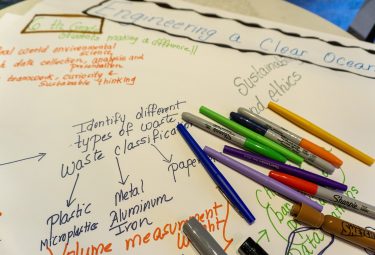Join us at the 2026 January ESIP Meeting! Register.
Now Hear This! A FUNding Friday Sonification Project
ESIP Community Fellow and PhD student, Patrick Chandler, describes his 2018 FUNding Friday Project.
Overview: The implications of climate data are difficult to understand through a single X Y graph. If time is included as a displayed variable, graphs can show either that temperature is increasing or that the amount of greenhouse gas is increasing, not both. Consequently, those reading the graph must use multiple graphs or be able to infer how the variables in one graph impact and influence other variables. To overcome the limitations of two-variable communication, I created a data sonification to communicate both the increase in atmospheric greenhouse gas and the consequent radiative forcing of that increase in a single data experience with the goal of designing a usable science sonification for visually impaired audiences and for the general public that motivates listeners to consider appropriate actions to combat climate change.
Methodology: I chose Max/MSP to create the sonification because it offers a simple and intuitive tool for the non-programmer to create a sound machine. Using predefined objects with embedded code enables the user to focus on function rather than learning a full programming language. The bangs, buttons, and objects of Max are very user friendly. “The Annual Greenhouse Gas Index (AGGI) is defined as the ratio of the total direct radiative forcing due to long-lived greenhouse gases for any year for which adequate global measurements exist to that which was present in 1990” (NOAA). Four sonifications were designed for this project to create four experiences of the AGGI representing gas abundance, proportionate radiative forcing, and comparative radiative forcing for the years 1980, 1990, 2000, and 2010. Sounds chosen were based on the percussive noises made by various clocks to create sense of urgency that comes from the increased clock tempo which is the audible representation of increased gas amounts and radiative forcing. The number of molecules encountered and their relative radiative forcing were represented with two different sets of sound, one played into the right speaker and the other played into the left, and the AGGI numbers (radiative forcing compared to 1990 values) were represented through audio volume.
A framework as criteria for design: After a review of several existing sonification projects was conducted, I discovered that projects which created the most usable and impactful sonifications addressed interdisciplinarity, stakeholder engagement, and usability from the project design stage. My project attempts to address those three variables in the following ways:
Interdisciplinarity: The design of this project required consultation from experts in the fields of science, music, education, and computer programming within the college community.
Stakeholder Engagement: The experts mentioned above represent one group of stakeholders and representatives from the two intended user groups, visually impaired individuals and members of the general public, will also be asked to help inform sonification design as progress continues. In order to include the visually impaired, the Colorado School for the Blind will be contacted this spring to find appropriate classrooms to demonstrate the sonification for students and record their feedback to assess whether the tool is effective in its goals. A pilot exhibit to solicit feedback from users at informal education institutions will also be designed for the general public. Both steps require further funding which is being sought.
Usability: Global scale environmental issues can create a sense of hopelessness. One way to avoid this is to focus on solutions when introducing the problems in order to leave learners empowered rather than worried. Meaningful solutions require an accurate understanding of the issue. This sonification hopes to provide that understanding. If listeners comprehend the disproportionate impact that CH4, NO2, and CFC12 have on global warming in addition to the amount of greenhouse gases present in the atmosphere, then they will have the ability to consider which actions are appropriate for each gas. For CO2, only major global efforts will be meaningful because of the amount of the gas that humans create and its prevalence in the atmosphere. Conversely, smaller targeted efforts that reduce CH4, NO2, CFC12 and other refrigerant associated gases may have significant impact. The overall usability of this project will be rated based on how listening to the sonification impacts listeners’ understanding of climate change and leads to further research and action. To test impact, a grounded theory approach will be used and semi-structured interviews with participants will take place six months after they listen to the sonification. Students and educators at the School for the Blind will be contacted through the school. Public participants who experience the sonification through an exhibit will be asked to provide an email so that they can also be contacted six months after they listen and educators from exhibit sites will also be interviewed. If the sonification doesn’t prove usable, then it will be modified through coordinated efforts of the expert team and retested.
If you would like to learn more about this sonification or talk about how to combine data and art, please contact me at Patrick.chandler@colorado.edu. To learn more about FUNding Friday, held annually at the ESIP Summer Meeting, see https://www.esipfed.org/funding-friday-rules.
More about Patrick: Patrick is a PhD student in the Environmental Studies Program at the University of Colorado, Boulder. His research is focused on the methodologies and impacts of combining art and science to communicate about environmental issues, and he hopes to publish a guide for communities and organizations on that subject. Patrick also works as an Education Consultant for the Washed Ashore Project where he was Education Director before starting his PhD and has ten years’ experience developing environmental education, stewardship, and science programs including curricula. Previously, Patrick served as the International Coastal Cleanup Coordinator for Alaska and was the Special Programs Coordinator for the Center for Alaskan Coastal Studies. Patrick is currently supporting the CLEAN Network as part of his ESIP Community Fellowship.



